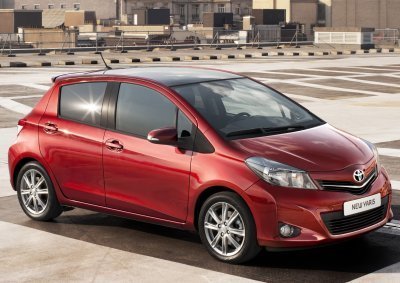New Yaris loses petite streak

Toyota says its all-new Yaris has spacious interiors with an upmarket feel, while remaining a car perfectly at home in the compact vehicle segment.
With an overall length just shy of 3.9 metres, the wheelbase is longer by 50mm which, crucially, signals more leg room for passengers, particularly those squeezed onto the rear bench. However, the longer length is offset by shorter front and rear overhangs that, along with a lower roofline and bolder wheelarches, also give the car a sportier appearance.
This is coupled with an all-new design showing of slimline headlights and bold air intakes at the front, an A-pillar that has been moved further back, allowing for a more raked windscreen and a new take on the familiar Yaris rear-end.
Toyota says it has agility to match is more athletic looks, but remains comfortable for its occupants. Instruments are behind the steering wheel (where they should be) and the dashboard is now 30mm wider than before with soft padding to match the door panel and seat pads… Metal trim around the instruments, air vents and switchgear adds a quality touch to the cabin while a new seat design with a wider squab is said to be more comfortable on longer journeys.
To deal with city living, the Yaris’ interior can be arranged in a number of ways to allow the car fulfil various needs. The rear bench splits 60/40 to accommodate bulkier objects. Overall luggage capacity has grown to 347 litres (to roof line) with the rear seats in place, 768 litres when they are folded flat.
As for firepower, the Yaris retains its 1-litre and 1.3-litre petrol engines, but adds a 1.4-litre D-4D turbodiesel. Toyota SA said the range will be expanded when the new Yaris is launched in South Africa before the end of 2011, but would not confirm the local introduction of the small-capacity D-4D.
All engines employ Toyota Optimal Drive, a range of weight-saving and aerodynamic improvements to help cut fuel consumption and emissions while ensuring output doesn’t suffer too dramatically.
The Yaris’s 1.3-litre engine with dual VVT-i also comes with a Smart Stop idling stop function to reduce fuel consumption to around 4.2 litres per 100km.
More concrete safety systems that Yaris owners have become accustomed to are provided on the new car. These include a full range of airbags, EBD and whiplash protection.
Furthermore, the new Yaris’ body has been designed to be more kind towards pedestrian heads and legs in the case of a collision.
The next-generation Toyota Yaris is expected to be launched in South Africa in the last quarter of 2011.
Related News


